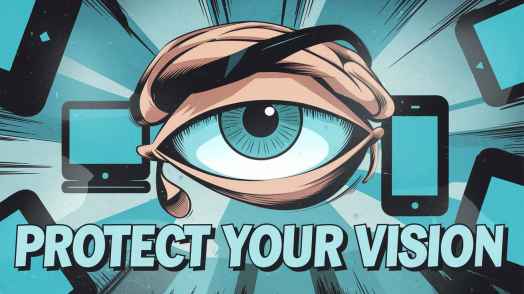Introduction
These days, almost everyone spends hours of their vision looking at screens—whether for work, fun, or chatting with friends., tech makes life easier, but it problems too. One big issue is digital eye strain. This modern problem, sometimes called computer vision syndrome, can really mess with your eyes. Dry eyes? Yes. Headaches? Yes. Blurred vision and neck pain? Sadly, yes.
There’s good news! A few easy tech tweaks and mindful habits can protect your eyes. In this guide, you’ll find practical tips to make screen time easier on your eyes.
Understanding Eye Strain in the Digital Age
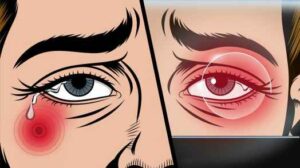
What is digital eye strain?
Digital eye strain, also known as computer vision syndrome, is the discomfort our eyes feel after staring at screens for extended periods. It’s like when you’ve been reading a book for hours, and your eyes start to feel tired, but with digital devices, it happens much faster.
Common symptoms of eye fatigue
Have you ever noticed your eyes feeling dry or itchy after a long day at the computer? That’s eye fatigue for you! Other common symptoms include:
- Blurred vision
- Headaches
- Neck and shoulder pain
- Difficulty focusing
I remember once working on a project late into the night and my eyes felt so strained, I could barely keep them open. It’s not a pleasant experience, trust me!
Long-term effects of prolonged screen time
While occasional eye strain isn’t typically serious, prolonged exposure to screens without proper care can lead to more persistent issues. Some potential long-term effects include:
- Chronic dry eye
- Nearsightedness
- Disrupted sleep patterns due to blue light exposure
It’s a bit scary to think about, isn’t it? But don’t worry, we’re here to learn how to prevent these issues!
Optimizing Your Display Settings
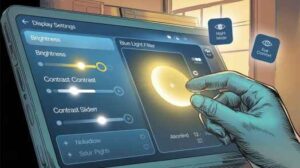
Adjusting screen brightness and contrast
Finding the right balance of brightness and contrast can make a world of difference. I like to adjust my screen brightness to match the lighting in my room. A good rule of thumb is to make sure your screen isn’t brighter than your surroundings.
Implementing blue light filters
Blue light filters are like sunglasses for your screen. They reduce the amount of blue light emitted, which can help reduce eye strain and improve sleep. Most devices now have built-in blue light filters, often called “Night mode” or “Eye comfort.”
Choosing the right color temperature
Color temperature affects how warm or cool your screen appears. Warmer colors (more yellow) are often easier on the eyes, especially in the evening. I find that a slightly warm tone helps me work comfortably for longer periods.
Ergonomic Workspace Setup
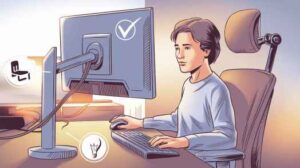
Proper monitor positioning
The position of your monitor can greatly impact eye strain. Ideally, your screen should be about an arm’s length away and slightly below eye level. This helps reduce neck strain and keeps your eyes more comfortable.
Ideal seating and posture
Good posture isn’t just about your back – it affects your eyes too! Sitting up straight with your feet flat on the floor can help reduce overall body strain, including eye fatigue.
Lighting considerations for your workspace
Proper lighting is crucial for reducing eye strain. Natural light is best, but if that’s not possible, aim for soft, diffused lighting. Avoid harsh overhead lights or working in the dark with only your screen for illumination.
Taking Regular Breaks
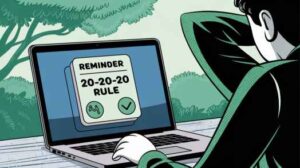
The 20-20-20 rule explained
The 20-20-20 rule is a simple but effective way to give your eyes a break. Every 20 minutes, take 20 seconds to look at something 20 feet away. It’s like a mini-vacation for your eyes!
Incorporating micro-breaks into your routine
Besides the 20-20-20 rule, try to take short breaks throughout your day. Stand up, stretch, or grab a glass of water. Your eyes (and your body) will thank you.
Using break reminder apps and tools
If you’re like me and tend to get absorbed in your work, break reminder apps can be a lifesaver. They’ll gently nudge you to take those important eye breaks.
Enhancing Your Device’s Visual Comfort

Increasing text size and adjusting fonts
Squinting at tiny text is a surefire way to strain your eyes. Don’t be afraid to increase the font size on your devices. Choose clear, easy-to-read fonts for a more comfortable viewing experience.
Using dark mode and high-contrast themes
Dark mode can be a game-changer, especially in low-light environments. It reduces the overall brightness of your screen while maintaining readability. High-contrast themes can also make text easier to read, reducing eye strain.
Customizing cursor and pointer sizes
If you find yourself squinting to locate your cursor, try increasing its size. Most operating systems allow you to customize cursor size and color for improved visibility.
Maintaining Good Eye Health

Regular eye exams and their importance
Just like you’d go to the dentist for a check-up, your eyes need regular check-ups too. An eye doctor can catch potential issues early and ensure your prescription (if you have one) is up to date.
Proper hydration and blinking exercises
Staying hydrated helps keep your eyes moist and comfortable. Also, remember to blink! When we’re focused on screens, we tend to blink less, which can lead to dry eyes. Try some blinking exercises blinking exercises – it might feel silly, but it helps!
Nutrition for eye health
Eating a balanced diet rich in vitamins A, C, and E, as well as omega-3 fatty acids, can support eye health. Think leafy greens, fish, and colorful fruits and vegetables. Your eyes will love you for it!
Key Takeaways for Reducing Eye Strain
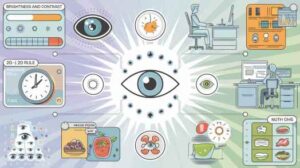
- Optimize your display settings for comfort
- Set up an ergonomic workspace
- Take regular breaks using the 20-20-20 rule
- Enhance visual comfort on your devices
- Maintain good eye health through regular check-ups and proper nutrition
Conclusion
Caring for your eyes in the age of screens doesn’t need to be hard. Just a few simple changes to your display settings and set up an ergonomic workspace can help a lot. Follow easy routines like the 20-20-20 rule (look away every 20 minutes for 20 seconds at something 20 feet away). And, regular eye check-ups and eating healthy will keep your eyes in top shape.
Screens are everywhere now. But with these simple tweaks, you can keep your vision comfy and clear. Make eye health a priority today to avoid strain and tiredness later on!
Read Also: Google Maps New Adventure: Unlocking History & Boosting Navigation
FAQs
1. How long should I use screens before taking a break?
It’s best to take short breaks every 20-30 minutes, even if it’s just for a few seconds to look away from your screen.
2. Are blue light glasses effective in reducing eye strain?
While research is ongoing, many people find blue light glasses helpful in reducing eye strain, especially when using screens at night.
3. Can eye strain cause permanent damage to my vision?
Generally, eye strain doesn’t cause permanent damage. However, prolonged, unaddressed eye strain can lead to more persistent discomfort and potentially worsen existing vision issues.
4. What are the best monitor settings for reducing eye fatigue?
The best settings vary by individual and environment, but generally, lower brightness, warmer color temperature, and higher contrast can help reduce eye fatigue.
5. How can I reduce eye strain when using my smartphone?
Try increasing font size, using dark mode, taking regular breaks, and holding your phone at a comfortable distance (about 12-18 inches from your face).
